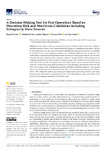Mostrar o rexistro simple do ítem
A decision-making tool for port operations based on downtime risk and met-ocean conditions including infragravity wave forecast
| dc.contributor.author | Costas Gómez, Raquel | |
| dc.contributor.author | Carro Fidalgo, Humberto | |
| dc.contributor.author | Figuero, A. | |
| dc.contributor.author | Peña González, Enrique | |
| dc.contributor.author | Sande, José | |
| dc.date.accessioned | 2023-04-26T16:01:39Z | |
| dc.date.available | 2023-04-26T16:01:39Z | |
| dc.date.issued | 2023 | |
| dc.identifier.citation | Costas, R.; Carro, H.; Figuero, A.; Peña, E.; Sande, J. A Decision-Making Tool for Port Operations Based on Downtime Risk and Met-Ocean Conditions including Infragravity Wave Forecast. J. Mar. Sci. Eng. 2023, 11, 536. https://doi.org/10.3390/jmse11030536 | es_ES |
| dc.identifier.uri | http://hdl.handle.net/2183/32947 | |
| dc.description.abstract | [Abstract:] Port downtime leads to economic losses and reductions in safety levels. This problem is generally assessed in terms of uni-variable thresholds, despite its multidimensional nature. The aim of the present study is to develop a downtime probability forecasting tool, based on real problems at the Outer Port of Punta Langosteira (Spain), and including infragravity wave prediction. The combination of measurements from three pressure sensors and a tide gauge, together with machine-learning techniques, made it possible to generate long wave prognostication at different frequencies. A fitting correlation of 0.95 and 0.9 and a root mean squared error (RMSE) of 0.022 m and 0.012 m were achieved for gravity and infragravity waves, respectively. A wave hindcast in the berthing areas, met-ocean forecast data, and information on 15 real operational problems between 2017 and 2022, were all used to build a classification model for downtime probability estimation. The proposed use of this tool addresses the problems that arise when two consecutive sea states have thresholds above 3.97%. This is the limit for guaranteeing the safety of port operations and has a cost of just 0.6 unnecessary interruptions of operations per year. The methodology is easily exportable to other facilities for an adequate assessment of downtime risks. | es_ES |
| dc.description.sponsorship | This research was carried out with the grant PID2020-112794RB-I00 funded by MCIN/AEI/10.13039/501100011033 and the FPI predoctoral grants from the Spanish Ministry of Science, Innovation, and Universities (PRE2018-083777 and PRE2021-100141). | |
| dc.language.iso | eng | es_ES |
| dc.publisher | MDPI | es_ES |
| dc.relation | info:eu-repo/grantAgreement/AEI/Plan Estatal de Investigación Científica y Técnica y de Innovación 2017-2020/PID2020-112794RB-I00 | es_ES |
| dc.relation | info:eu-repo/grantAgreement/AEI/Plan Estatal de Investigación Científica y Técnica y de Innovación 2017-2020/PRE2018-083777 | es_ES |
| dc.relation | info:eu-repo/grantAgreement/AEI/Plan Estatal de Investigación Científica y Técnica y de Innovación 2017-2020/PRE2021-100141 | es_ES |
| dc.relation.uri | https://doi.org/10.3390/jmse11030536 | es_ES |
| dc.rights | Atribución 3.0 España | es_ES |
| dc.rights.uri | http://creativecommons.org/licenses/by/3.0/es/ | * |
| dc.subject | Long waves prediction | es_ES |
| dc.subject | Port operability | es_ES |
| dc.subject | Multidimensional operational threshold | es_ES |
| dc.subject | Machine learning | es_ES |
| dc.subject | Port management | es_ES |
| dc.title | A decision-making tool for port operations based on downtime risk and met-ocean conditions including infragravity wave forecast | es_ES |
| dc.type | info:eu-repo/semantics/article | es_ES |
| dc.rights.access | info:eu-repo/semantics/openAccess | es_ES |
| UDC.journalTitle | Journal of Marine Science and Engineering | es_ES |
| UDC.volume | 11 | es_ES |
| UDC.issue | 3 | es_ES |
| UDC.startPage | 536 | es_ES |
| dc.identifier.doi | 10.3390/jmse11030536 |






